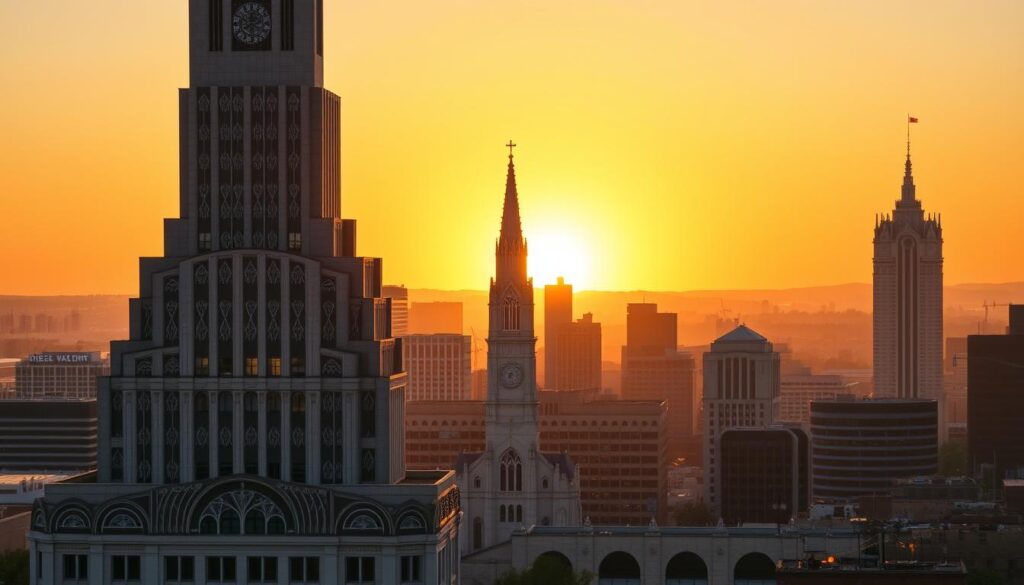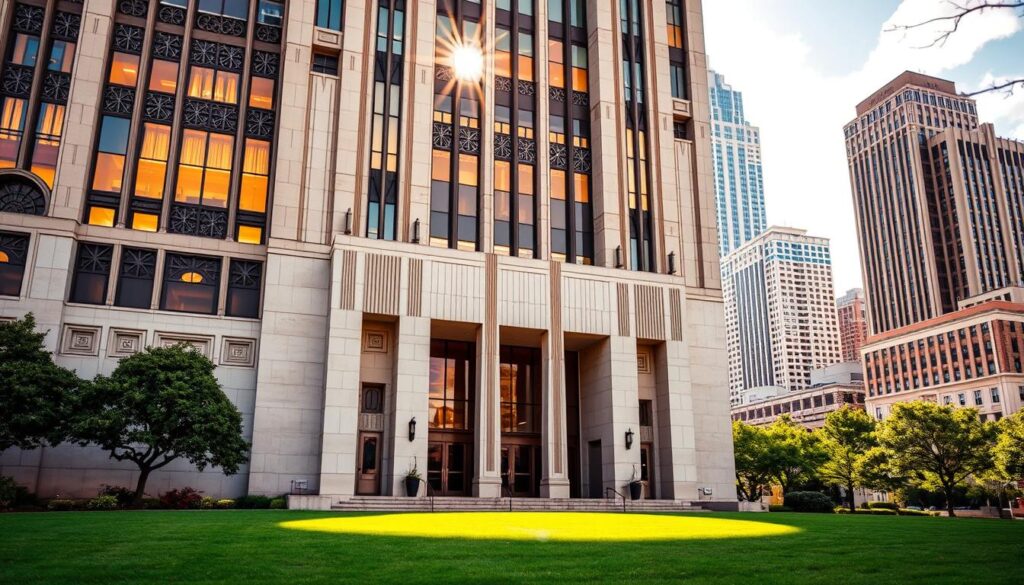Art Deco architecture fans will find one of the biggest collections in America within Tulsa city limits. During the early 20th century Tulsa transformed into an innovative center of style because of rapid oil industry growth in its midwestern region. The nickname of the 1920s as “The Jazz Age” introduced cultural movements which led to the distinctive spirit of the city of Tulsa.
Oil barons together with architects saw rapid success in the city which resulted in the creation of magnificent Art Deco architectural works. During this period of prosperity and innovation these buildings presented geometric designs accompanied by powerful lines which display both prosperity and creative flair. The architectural features of downtown Tulsa demonstrate both business-minded development and design excellence in its high-rise structures as well as in its reused historical buildings.
The historical structures endure as actively serving memorials which commemorate the previous era. Through these landmarks visitors can see how Tulsa grew into its status of “Oil Capital of the World.” Preservation efforts continue because the city maintains its appreciation for art and design which ensures these historic treasures can be passed on to future generations.
Key Takeaways
- Tulsa has achieved national distinction by holding the second-biggest Art Deco building collection in America.
- The city experienced its architectural transformation during the period of oil boom which began in the 1920s.
- The Art Deco design approach uses strong linear elements together with mathematical structural forms.
- Downtown Tulsa preserves numerous significant old buildings which now have new uses.
- The architectural landmarks of Art Deco in Tulsa showcase both the city’s financial development and its social atmosphere.
- Tulsa’s Rich Legacy and the Birth of Art Deco
The discovery of oil deposits near the Arkansas River made Tulsa into an expanding urban center. Tulsa experienced economic growth so significant that it resulted in both financial prosperity and cultural enthusiasm which transformed the city identically. In the 1920s Tulsa developed into an innovative center which drew significant business figures together with skilled architects.

Oil Boom and Cultural Transformation
The second oil boom in the Arkansas River region transformed the city of Tulsa into a rapid growth center. The oil wealth constructed several new buildings along with famous landmarks across the region. The oil boom established a city beyond generating wealth because according to local historian Shane Hood. Metropolitan business owners began moving to the region at this time while carrying their preference for present-day architectural styles.
Newcomers influenced Tulsa architectural style by demanding buildings that showcased prosperity through modern designs. The city incorporated present-day Art Deco architectural principles to establish a different and forward-thinking identity throughout the Midwest region. Artists and architects formed a crucial force in developing Tulsa’s cityscape through the combination of European architectural trends with original local concepts.
Emergence of a Modern Architectural Identity
The 1925 Paris Exhibition at the Exposition held in the city influenced all of Tulsa’s architectural development as it displayed contemporary Art Deco designs. The worldwide exhibition motivated local construction professionals to develop geometric ingredients combined with strong line features and detailed elements. The new architectural style used public institutions together with commercial buildings as its primary portraying mediums.
A prime representation of deco architecture stands as the Boston Avenue Methodist Church among many other deco landmarks in Tulsa. The church’s pinnacle towers above the city as a tribute to Tulsa’s aspiration for architectural artistry. After the completion of this church together with other landmarks on Boston Avenue they emerged as cultural and economic progress symbols of Tulsa.
These architectural structures maintain their existence today to demonstrate how the city transformed throughout that decisive historical period. These structures show us how Tulsa progressed from its humble beginnings to become a shining example of progress and fashion.
Historical Gems: Will Rogers High School and the Philcade
Deco architecture demonstrates itself beautifully through Will Rogers High School. The WPA construction produced this building when it displayed both terra-cotta statues alongside elaborate aesthetics. The design of this building demonstrates the city’s devotion to educational institutions together with artistic development.
The Philcade introduced Tulsa commercial interests toward Boston Avenue by means of its gold leaf design and sophisticated architectural style. The building stands out throughout downtown Tulsa because of its magnificent lobby which incorporates unique geometric decorations.
| Building | Architect | Notable Features |
|---|---|---|
| Boston Avenue Methodist Church | Adah Robinson | Towering spire, intricate carvings |
| Philcade Building | Leon Senter | Geometric patterns, ornate lobby |
| Will Rogers High School | Bruce Goff | Organic forms, innovative materials |
The architectural masterpiece of Tulsa can be studied by exploring its Art Deco buildings found throughout Oklahoma
Tulsa demonstrates its architectural talent through the collection of buildings that create its skyline. The buildings built in the Art Deco style in Tulsa present an exclusive combination of modern materials with ornamental details and geometric design elements. The urban landscape gained its present appearance through creative and ambitious development activities from that period.
Architectural Pioneers and Historic Preservation
Local architects Bruce Goff and Leon Senter became essential figures who formed the architectural character of Tulsa. The architect designers united European modernistic elements with indigenous creative aspects to create notable architectural works. Through his work Goff demonstrated a clear preference for natural-shaped structures that tested different building materials.
These precious architectural masterpieces would have disappeared without historic preservation movements. Through the work of the Tulsa Foundation for Architecture organizations lead the preservation efforts for restoring Art Deco architectural landmarks. The preservation activities of these organizations maintain these buildings for current and future communities to be inspired.
The Role of Art and Design in Shaping the City
Art and design play a foundational role in the identity which makes up Tulsa. Multiple artistic elements with functional needs can be observed within both public and private buildings. The Boston Avenue Methodist Church represents deco architecture perfectly by uniting religious symbolism with contemporary design elements.
The historical buildings of the city have adjusted their purposes without changing fundamental design aspects from their original periods. Using this approach contemporary society both safeguards past resources and finds new uses for them. The city displays strong dedication to preservation because it understands the architectural value of its legacy.
Art Deco architectural practices from the past continue to have substantial effects on modern art development together with current architectural styles throughout Tulsa. The city maintains complete dedication to conserving its historic architectural heritage which keeps alive its exclusive style for future generations.
Iconic Art Deco Landmarks in Tulsa
The Art Deco buildings in Tulsa exist as innocent monuments which narrate significant historical events. Tulsa’s architectural masterpieces function as cultural and economic achievements that stand proudly as city landmarks. The structures share their stories about innovation combined with ambition as well as artistic direction.




